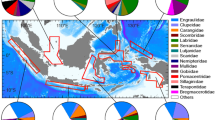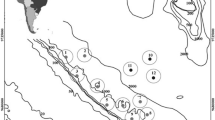Abstract
Previous analysis of the Continuous Plankton Recorder (CPR) long-term data set for the presence of ‘coelenterate’ tissue revealed changes in the frequency of jellyfish occurrence in the North Atlantic Ocean and North Sea; however, the identities of the jellyfish were unknown, causing uncertainty in interpreting these findings. To improve the utility of the ‘coelenterate’ data from the CPR, 62 CPR samples were selected for re-analysis from an area where the widespread occurrence of the holoplanktonic scyphomedusan, Pelagia noctiluca (Forsskål, 1775), was previously documented from net tows to test if the CPR sampled P. noctiluca. Examination of the samples revealed smears (<1 mm) of golden gelatinous tissue on the sampling mesh. Subsequent microscopic examination and measurement of nematocysts identified most of the smears as P. noctiluca. Indeed, P. noctiluca was identified on 53% of the CPR samples from the area that best coincided with the documented bloom area. Although hydrozoans were also identified in the samples, the characteristic golden colour of P. noctiluca and its distinct suite of nematocysts allowed identification to species level. The identification of other jellyfish may be more complicated due to the labour-intensive examination of samples and unclear delineation of nematocyst types when multiple similar species are present. Nevertheless, re-analysis of CPR samples holds great promise for identifying the underlying reason for increases in jellyfish occurrence in the CPR records.


Similar content being viewed by others
References
Ariza, E., J. Jiménez & R. Sardá, 2008. A critical assessment of beach management on the Catalan coast. Ocean and Coastal Management 51: 141–160.
Attrill, M. J. & M. Edwards, 2008. Reply to Haddock, S.H.D. Reconsidering evidence for potential climate-related increases in jellyfish. Limnology and Oceanography 53: 2763–2766.
Attrill, M. J., J. Wright & M. Edwards, 2007. Climate-related increases in jellyfish frequency suggest a more gelatinous future for the North Sea. Limnology and Oceanography 52: 480–485.
Avian, M., P. Negro & L. Sandrini, 1991. A comparative analysis of nematocysts in Pelagia noctiluca and Rhizostoma pulmo from the North Adriatic Sea. Hydrobiologia 52: 480–485.
Beaugrand, G., F. Ibanez, J. A. Lindley & P. C. Reid, 2002. Diversity of calanoid copepods in the North Atlantic and adjacent seas: species associations and biogeography. Marine Ecology Progress Series 232: 179–195.
Calder, D., 1977. Nematocysts of the ephyra stages of Aurelia, Chrysaora, Cyanea, and Rhopilema (Cnidaria, Scyphozoa). Transactions of the American Microscopical Society 96: 13–19.
Doyle, T. K., J. D. R. Houghton, S. M. Buckley, G. C. Hays & J. Davenport, 2007. The broad-scale distribution of five jellyfish species across a temperate coastal environment. Hydrobiologia 579: 29–39.
Doyle, T. K., H. De Haas, D. Cotton, B. Dorschel, V. Cummins, J. D. R. Houghton, J. Davenport & G. C. Hays, 2008. Widespread occurrence of the jellyfish Pelagia noctiluca in Irish coastal and shelf waters. Journal of Plankton Research 30: 963–968.
Edwards, M. & A. J. Richardson, 2004. Impact of climate change on marine pelagic phenology and trophic mismatch. Nature 430: 881–884.
Fraser, J. H., 1955. The plankton of the waters approaching the British Isles in 1953. Marine Research 1: 1–12.
Gibbons, M. J. & A. J. Richardson, 2009. Patterns of jellyfish abundance in the North Atlantic. Hydrobiologia 616: 51–65.
Haddock, S. H. D., 2008. Reconsidering evidence for potential climate-related increases in jellyfish. Limnology and Oceanography 53: 2759–2762.
Hardy, A., 1935. The continuous plankton recorder: a new method of survey. Rapports et Proces-Verbaux des Reunions. Conseil International pour l’Exploration de la Mer 95: 36–47.
Hays, G. C., 1994. Mesh selection and filtration efficiency of the Continuous Plankton Recorder. Journal of Plankton Research 16: 403–412.
Hays, G. C., M. R. Carr & A. H. Taylor, 1993. The relationship between Gulf Stream position and copepod abundance derived from the Continuous Plankton Recorder Survey: separating biological signal from sampling noise. Journal of Plankton Research 15: 1359–1373.
Kirby, R. & J. Lindley, 2005. Molecular analysis of Continuous Plankton Recorder samples, an examination of echinoderm larvae in the North Sea. Journal of the Marine Biological Association of the UK 85: 451–459.
Macrokanis, C., N. Hall & J. Mein, 2004. Irukandji syndrome in northern Western Australia: an emerging health problem. Medical Journal of Australia 181: 699–702.
Östman, C., 2000. A guideline to nematocyst nomenclature and classification, and some notes on the systematic value of nematocysts. Scientia Marina 64: 31–46.
Östman, C. & J. Hydman, 1997. Nematocyst analysis of Cyanea capillata and Cyanea lamarckii (Scyphozoa, Cnidaria). Scientia Marina 61: 313–344.
Purcell, J. E., 2009. Extension of methods for jellyfish and ctenophore trophic ecology to large-scale research. Hydrobiologia 616: 23–50.
Purcell, J. E. & M. N. Arai, 2001. Interactions of pelagic cnidarians and ctenophores with fish: a review. Hydrobiologia 451: 27–44.
Purcell, J. E., S. Uye & W. T. Lo, 2007. Anthropogenic causes of jellyfish blooms and their direct consequences for humans: a review. Marine Ecology Progress Series 350: 153–174.
Reid, P. C., M. Edwards, G. Beaugrand, M. Skogen & D. Stevens, 2003. Periodic changes in the zooplankton of the North Sea during the twentieth century linked to oceanic inflow. Fisheries Oceanography 12: 260–269.
Richardson, A. J., A. W. Walne, A. G. W. John, T. D. Jonas, J. A. Lindley, D. W. Sims, D. Stevens & M. Witt, 2006. Using continuous plankton recorder data. Progress in Oceanography 68: 27–74.
Russell, F. S., 1938. On the nematocysts of hydromedusae. Journal of the Marine Biological Association of the United Kingdom 23: 145–165.
Russell, F. S., 1940. On the nematocysts of hydromedusae. III. Journal of the Marine Biological Association of the United Kingdom 24: 515–523.
Russell, F. S., 1970. The Medusae of the British Isles: II. Cambridge University Press, Cambridge.
Sabatés, A., F. Pagès, D. Atienza, V. L. Fuentes, J. E. Purcell & J.-M. Gili. Planktonic cnidarian distribution and feeding of Pelagia noctiluca from near shore to open sea in the NW Mediterranean Sea. Hydrobiologia. doi:10.1007/s10750-010-0221-z.
Warner, A. J. & G. C. Hays, 1994. Sampling by the Continuous Plankton Recorder Survey. Progress in Oceanography 34: 237–256.
Witt, M. J., A. C. Broderick, D. J. Johns, C. Martin, R. Penrose, M. S. Hoogmoed & B. J. Godley, 2007. Prey landscapes help identify potential foraging habitats for leatherback turtles in the NE Atlantic. Marine Ecology Progress Series 337: 231–243.
Acknowledgements
This project [Grant-Aid Agreement No PBA/AF/08/002(01)] was carried out under the Sea Change strategy with the support of the Marine Institute and the Marine Research Sub-Programme of the National Development Plan 2007–2013, co-financed under the European Regional Development Fund. EJB was supported by the above grant aid. TKD was supported by an Irish Research Council for Science Engineering and Technology fellowship. The authors would like to acknowledge all past and present members and supporters of the CPR survey, especially the ships that voluntarily tow CPRs on regular routes and the Sir Alister Hardy Foundation for Ocean Science (SAHFOS) for facilitating the use of the CPR samples and the SAHFOS laboratories. We thank G. Hays and two other anonymous reviewers for their comments on the article.
Author information
Authors and Affiliations
Corresponding author
Additional information
Guest editors: J. E. Purcell & Dror Angel / Jellyfish Blooms: New Problems and Solutions
Rights and permissions
About this article
Cite this article
Baxter, E.J., Walne, A.W., Purcell, J.E. et al. Identification of jellyfish from Continuous Plankton Recorder samples. Hydrobiologia 645, 193–201 (2010). https://doi.org/10.1007/s10750-010-0212-0
Published:
Issue Date:
DOI: https://doi.org/10.1007/s10750-010-0212-0




